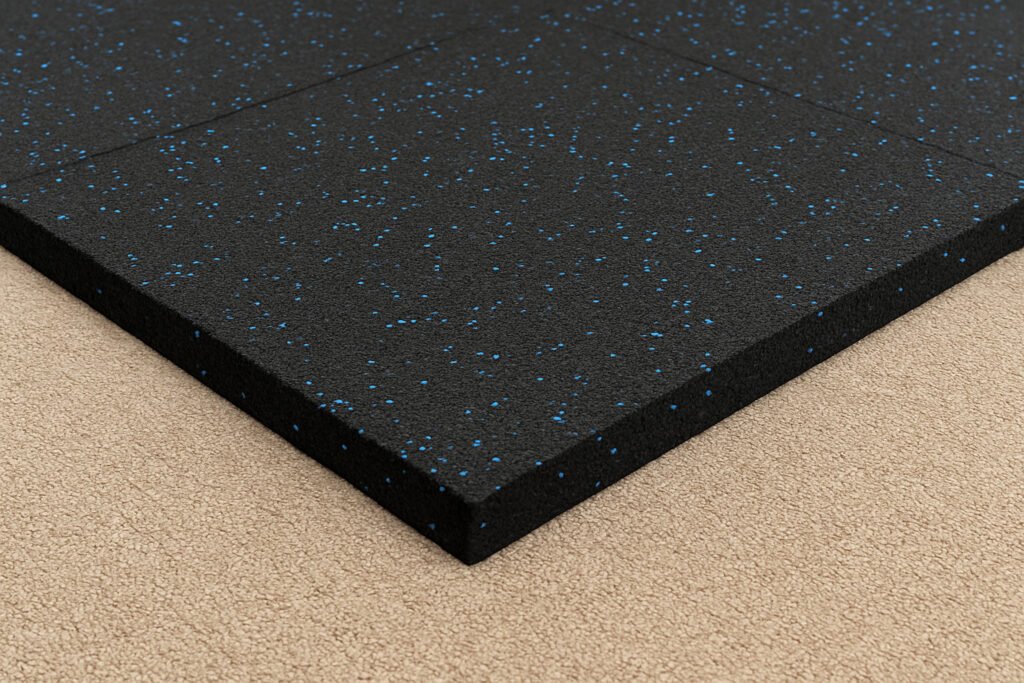Can You Install Rubber Gym Flooring Over Carpet?
Trying to install gym flooring over carpet sounds convenient—but it can quickly become a costly mistake if not done right.
Yes, you can install rubber gym flooring over carpet, but only with the right products and methods. For best results, use heavy, stable options like composite rubber tiles.

Most people think installing gym flooring over carpet is as easy as rolling it out. But when your flooring shifts, wrinkles, or traps moisture underneath, your gym becomes unsafe and hard to maintain. If your clients or staff are training on a loose surface, it affects their performance and increases injury risk. That’s why this question comes up often—especially from gym owners, contractors, and distributors.
Let’s break down the reality.
Why Is Installing Over Carpet a Problem?
Laying gym floor over soft carpet sounds easy—but is it safe?
Rubber flooring over soft carpet often leads to instability, poor support for equipment, and safety hazards. It can void warranties on both the carpet and gym flooring.
Rubber floors need a stable, hard base to function well. When installed over soft carpet, the floor can shift or sag, especially under heavy equipment like squat racks. This makes the surface unsafe and can cause premature wear on both your carpet and your gym flooring. Moisture can also get trapped underneath and lead to mold, smell, or bacteria build-up—something nobody wants in a fitness space.
Here’s a breakdown of the risks:
| Problem | What Happens |
|---|---|
| Instability | Shifting tiles or rolls underfoot |
| Equipment Damage | Uneven base affects performance of machines |
| Hygiene | Carpet traps moisture under flooring |
| Warranty Voids | Many products are not rated for soft bases |
If you absolutely must install over carpet, you need the right type of gym floor.
What’s the Best Rubber Flooring Option for Carpeted Areas?
So, what kind of rubber flooring actually works on top of carpet?
The best solution is Lanhefloor’s composite rubber tile—it’s heavy, durable, and has a laminated surface layer that sits well over carpet.

Composite rubber tiles have a solid weight and structure that minimizes shifting. These tiles are made from a dense SBR base topped with a 1.5mm EPDM laminated layer. This gives them both traction and stability, even on softer carpet surfaces. They’re also easy to clean and maintain. If you’re in a functional training space or PT zone, they’re a smart choice.
For thin carpet or short pile, interlocking tiles might work too. But for thick plush carpet? It’s safer to remove it or add a plywood layer underneath before installing.
Here’s a summary of the best options:
| Product Type | Can Be Used on Carpet? | Notes |
|---|---|---|
| Composite Rubber Tile | ✅ Yes | Best for weight zones |
| Interlocking Tile | ⚠️ Maybe | Only for flat, firm carpet |
| Rubber Roll | ❌ No | Too flexible—shifts easily |
What Do My Customers Usually Ask?
Here are a few common questions we get from people like Mark in Australia or Sean in Spain.
“Will it damage my carpet underneath?”
Yes, over time, rubber tiles can compress and leave marks. If you plan to keep the carpet, place a plywood base layer underneath.
“Can I use rubber rolls on carpet?”
No, rubber rolls are flexible and need a solid base to work properly. They will move or wrinkle on soft surfaces.
“What about home gyms?”
For home gyms, interlocking rubber tiles are easy to install and remove. They’re a good choice if you’re renting or want flexibility.
“Do I need glue?”
If using composite tiles over carpet, glue is not required. Their weight keeps them in place.
More Helpful Links
To explore more flooring options for your space:
- Lanhefloor Main Site
- Tiny Granule Rubber Tile
- Rubber Roll for Cardio/Yoga Zones
- Outdoor Rubber Floor
- EPDM Granules for Playground or Track
- Gym Rubber Tile Collection
- Project References
Conclusion
Yes, you can install gym flooring over carpet—but only with the right rubber tile products like composite tiles. Avoid rubber rolls unless your base is firm.
